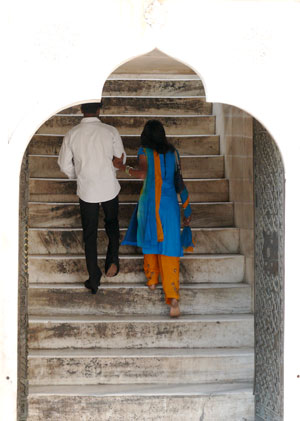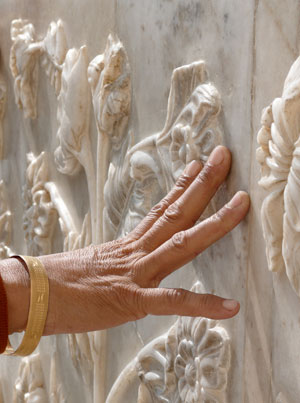AGRA, INDIA - A handsome young man escorts a pretty woman to a bench outside the main entrance to the Taj Mahal, India’s monument to love.
It’s not just any bench. This one has become affectionately known as the Lady Di Bench, named after the late Princess of Wales who was caught in a solitary moment during a visit here on the eve of her breakup with Prince Charles.
The young man nervously looks around, drops to one knee and produces a ring, which he slips onto the woman’s finger. She gasps and then buries her face in her hands, emerging a few seconds later teary eyed but smiling. She reaches out and the two embrace, clasp hands and disappear into the yawning entrance of the white marble mausoleum affectionately known as India’s “Love Palace”.
Bharat, our guide, has seen this scene played out many times over the 18 years he’s lead visitors around the Taj Mahal, India’s most visited attraction.
“I had an American man propose to his girlfriend just a few days ago,” says Bharat. “Proposals happen all the time here. Everyone dreams of coming to the love palace. Whether young or old, this is the place where romantics make their pilgrimage — a place where love is always in the air.”
Bharat tells us that 90 per cent of visitors to India make the trek to Agra, a city of 2.5 million that sits south of Delhi and is known for its leather and marble industries.
“But the main industry here is tourism,” Bharat says after collecting us at Agra rail station after a pleasant two-hour train journey from New Delhi.
A few minutes after leaving the chaotic station, Bharat pulls into the parking lot of the famed Oberoi Hotel, itself a love palace whose complete inventory of rooms looks out on the famed Taj Mahal.
“We cannot go any further with our car,” Bharat tells us. “The hotel supplies golf carts which will take us to the Taj entrance.”
Everyone knows the story of the Taj Mahal, built by a heartbroken Shah Jahan after his beloved wife Mumtaz Mahal died.
“He was never the same man after she died,” Bharat says while we wait in a long queue at a heavily guarded entrance. “He was shattered and grew frail and old after her death. He was later imprisoned by his son and when he died, his body was brought here to lay beside his beloved wife.”
Because of the original tragic love connection, the iconic Taj Mahal has become known as “the teardrop on the cheek of time,” our guide tells us.
As we pass through the red sandstone entrance, Bharat points out a number of impressive outer buildings used to house family members and friends invited to attend Mumtaz Mahal’s funeral.


Left: Being the Love Palace, many young people come here to take their vows. Right: The stone work at the Taj is amazing.
“These structures are very impressive in their own right but they get lost in the glitter of the Taj Mahal,” says Bharat.
We then pass through the red sandstone arched entrance to the Taj Mahal which is inlaid with black and white marble calligraphy and motifs in floral and geometric designs. It’s as much an architectural masterpiece as the Taj Mahal and supplies us amateur photographers with that perfect silhouetted frame of the Muslim-like mosque that has become such a cherished photograph.
Few words can describe one’s first impressions of the Taj Mahal. It really is love at first sight. With the early morning sun bouncing off its snow white façade, one is left awestruck.
“Oh, this is so beautiful …”
“It looks like a wedding cake. ..” are some of the comments we hear as we pass through the enormous main gate and get our first uninterrupted view of the “Love Palace” that took 20,000 labourers 21 years to complete.
Photographs do not do this building justice. With what appears to be a permanent blue sky backdrop, the Taj, with its bulbous dome, is indeed the crown jewel of India.
“Pretty impressive,” Bharat says from behind as he offers to take our photograph in front of the reflective pools leading to the mighty structure, made of Indian marble, the hardest in the world.
“There’s a secret that not many people know about the Taj Mahal,” the guide informs us as we head toward the Princess Di Bench.
“The tombs in the main mausoleum are only replicas. The real tombs of Shah Jahan and Mumtaz Mahal lay beneath the main floor — hidden from view.
“The main floor tombs are decorated much more elaborately than the real tombs. That’s the way the Shah wanted it. He knew people would be coming here to see his wife’s tomb and he wanted them to be impressed while at the same time preserving his wife’s privacy in death.”
Both tombs on the main floor look like a pair of jewelled boxes with exquisite floral inlay designs studded with tiny precious stones. They are protected by octagonal screens that are carved from single sheets of marble and embellished with lacy filigree work and precious stones.
The exterior of the Taj Mahal is responsive to the changing light. Bharat tells us that is what makes this building so interesting to visit at different times of the day.
“Being here in the morning at sunrise is completely different than being here at sunset. The benign rays of the sun lend a soft purple hue to it at dawn which changes to a dazzling white during the harsh noon and then appears as a glorious golden hue against the backdrop of the setting sun.”
The façade of the Taj is resplendent with the finest decorative art. Some of the jewels that once made up the façade have been chipped away by treasure hunters but what remains still impresses. Panels with splendid carved relief work, floral sprays framed with pietra dura and stone inlay borders and inlaid calligraphy in black marble with Koranic inscriptions give the monument a jewel-like beauty.
The Taj Mahal is indeed a flawless gem — a timeless wonder that is an inspiration to photographers, painters, poets and of course, the love sick.
The Taj stretches almost 80 metres in height and sits in the centre of the 1.5 square kilometre complex that rests on the banks of the River Yamuna. It’s balanced by two redstone mosques — one a fake — and four, three-storey minarets.
“The minarets are actually leaning outward to the right of the Taj Mahal,” Bharat informs. “They were designed that way so in case of an earthquake they would fall away from the main structure. There have been three minor earthquakes in this area in modern times but the towers have remained standing,” he says.
The crush of people inside the main part of the Taj Mahal, which itself took 16 years to complete, is overwhelming.
“The Taj gets 10,000 visitors on average a day and sometimes there are upwards of 30,000 on the site,” says the guide.
It cost the Shah 40 million rupees at the time to build the Taj Mahal. Translated into today’s devalued rupee, that means it would take billions to duplicate this ancient wonder. The couple we saw when we arrived reappear as we are about to leave.
“So,” we ask the young man, “did she say yes?”
“Oh yes, sir,” he replies. “Love can not be denied at the Taj Mahal.” Touche!